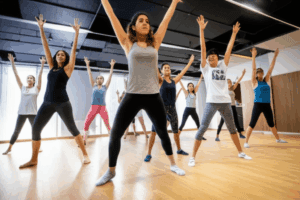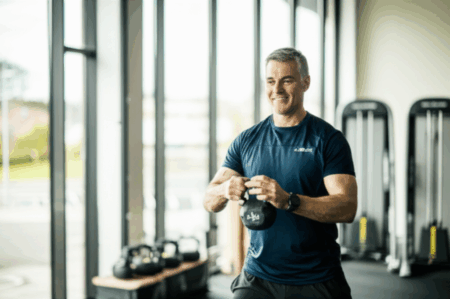Finding time for fitness can feel impossible, especially with the demands of work, family, and everything in between. But what if you could achieve significant health benefits with just two exercises a week? A doctor is sharing a simple yet effective routine designed specifically for busy women. This isn’t about spending hours at the gym; it’s about strategically incorporating movement into your life to boost your well-being.
The Time Crunch Dilemma: Why Simple is Key
Many women struggle to fit workouts into their schedules. Long hours, family commitments, and social obligations often leave little time for exercise. This can lead to feelings of guilt and frustration, making it even harder to prioritize fitness. The key is to find a routine that is both time-efficient and effective, making it easier to stick to in the long run.
Why a Minimalist Approach Works
A minimalist workout approach, focusing on just a few key exercises, can be surprisingly effective. It reduces the time commitment, making it more manageable for busy schedules. It also allows you to focus on proper form and technique, maximizing the benefits of each exercise. Furthermore, it can be less intimidating than complex routines, making it easier to get started and stay consistent.
The Doctor’s Recommendation: Two Exercises for a Healthier You
This simple routine focuses on compound exercises, which work multiple muscle groups simultaneously, providing a full-body workout in less time.
Exercise 1: Squats
Squats are a powerhouse exercise that targets the lower body, including the quads, glutes, and hamstrings. They also engage your core muscles, improving overall stability and posture.
How to perform a squat:
- Stand with your feet hip-width apart, toes slightly outward.
- Keep your back straight, chest up, and core engaged.
- Lower your hips as if you’re sitting back into a chair, bending your knees to approximately 90 degrees. Ensure your knees don’t extend past your toes.
- Keep your weight on your heels and maintain a neutral spine.
- Push through your heels to return to the starting position, squeezing your glutes at the top.
Benefits of squats:
- Strengthens lower body muscles: Squats effectively target the quads, glutes, and hamstrings, leading to increased strength and power in the lower body.
- Improves core stability: Engaging your core throughout the exercise helps improve stability and balance.
- Enhances functional fitness: Squats mimic everyday movements like sitting and standing, making daily activities easier.
- Burns calories: As a compound exercise, squats burn a significant amount of calories, contributing to weight loss and overall fitness.
Modifications:
- Beginner: Bodyweight squats, box squats (squatting onto a box or bench).
- Intermediate: Dumbbell squats, goblet squats (holding a dumbbell close to your chest).
- Advanced: Barbell squats, jump squats.
Exercise 2: Push-Ups
Push-ups are a classic upper-body exercise that targets the chest, shoulders, and triceps. They also engage your core muscles, contributing to overall stability.
How to perform a push-up:
- Start in a plank position with your hands shoulder-width apart, fingers pointing forward.
- Keep your body in a straight line from head to heels, engaging your core muscles.
- Lower your body towards the ground, bending your elbows to approximately 90 degrees.
- Push back up to the starting position, fully extending your arms.
Benefits of push-ups:
- Strengthens upper body muscles: Push-ups effectively target the chest, shoulders, and triceps, leading to increased strength and power in the upper body.
- Improves core stability: Engaging your core throughout the exercise helps improve stability and balance.
- Requires no equipment: Push-ups can be done anywhere, making them a convenient exercise for busy schedules.
- Scalable for all fitness levels: Push-ups can be modified to suit different fitness levels, making them accessible to everyone.
Modifications:
- Beginner: Wall push-ups, knee push-ups.
- Intermediate: Incline push-ups (hands elevated on a bench or step), standard push-ups.
- Advanced: Decline push-ups (feet elevated on a bench or step), plyometric push-ups (explosively pushing off the ground).
Crafting Your Weekly Routine
The beauty of this routine lies in its flexibility. Here’s a sample weekly schedule:
- Day 1: Squats (3 sets of 10-12 repetitions), Push-ups (3 sets of as many repetitions as possible with good form).
- Day 2: Rest or light activity (walking, stretching).
- Day 3: Squats (3 sets of 10-12 repetitions), Push-ups (3 sets of as many repetitions as possible with good form).
- Day 4-7: Rest or light activity.
Important Considerations:
- Warm-up: Before each workout, perform a 5-10 minute warm-up consisting of light cardio and dynamic stretching. Examples include arm circles, leg swings, and torso twists.
- Cool-down: After each workout, perform 5-10 minutes of static stretching, holding each stretch for 30 seconds. Focus on stretching the muscles worked during the workout, such as quads, hamstrings, chest, and shoulders.
- Proper Form: Prioritize proper form over the number of repetitions. Watch videos, use a mirror, or consult with a fitness professional to ensure you’re performing the exercises correctly.
- Progression: As you get stronger, gradually increase the difficulty of the exercises by adding weight, increasing repetitions, or trying more challenging variations.
- Listen to your body: Take rest days when needed and don’t push yourself too hard, especially when starting out.
The Science Behind the Simplicity
While this routine may seem too simple to be effective, it’s based on sound scientific principles.
Compound Exercises for Maximum Impact
Squats and push-ups are compound exercises, meaning they work multiple muscle groups simultaneously. This makes them more efficient than isolation exercises, which target only one muscle group at a time. Compound exercises also elevate your heart rate and burn more calories, contributing to overall fitness and weight management.
Strength Training for Women: Debunking Myths
Strength training is often mistakenly associated with bulky muscles, leading some women to avoid it. However, strength training offers numerous benefits for women, including:
- Increased muscle mass: Women naturally lose muscle mass as they age. Strength training helps counteract this by building stronger muscles.
- Increased metabolism: More muscle means a higher resting metabolism, enabling you to burn more calories even when you’re not working out.
- Bone health: Lifting weights increases bone density, reducing the risk of osteoporosis.
- Mental clarity: Physical activity, particularly strength training, releases endorphins which can improve mood and mental focus.
- Enhanced daily function: Stronger muscles make everyday tasks easier, reducing the risk of injury.
The Importance of Consistency
Consistency is key to seeing results from any workout routine. Even a simple routine, performed consistently, can lead to significant improvements in strength, fitness, and overall health. By keeping the routine manageable and time-efficient, you’re more likely to stick with it in the long run.
Beyond the Two Exercises: Building a Holistic Lifestyle
While this two-exercise routine is a great starting point, it’s important to complement it with other healthy habits.
Nutrition
A balanced diet is essential for overall health and fitness. Focus on eating whole, unprocessed foods, including plenty of fruits, vegetables, lean protein, and whole grains. Avoid sugary drinks, processed snacks, and excessive amounts of unhealthy fats.
Cardio
While the two-exercise routine provides a good foundation of strength training, incorporating some cardio into your week can further enhance your fitness. Aim for at least 150 minutes of moderate-intensity aerobic activity per week, such as brisk walking, jogging, cycling, or swimming.
Flexibility and Mobility
Stretching and mobility exercises are important for maintaining flexibility and preventing injuries. Incorporate stretching into your warm-up and cool-down routines, and consider adding activities like yoga or Pilates to your weekly schedule.
Rest and Recovery
Adequate rest and recovery are crucial for allowing your body to repair and rebuild muscle tissue. Aim for 7-8 hours of sleep per night and take rest days when needed.
Tailoring the Routine to Your Needs
This two-exercise routine is a starting point that can be tailored to your individual needs and preferences.
Fitness Level
If you’re new to exercise, start with the beginner modifications and gradually progress to more challenging variations as you get stronger. If you’re already active, you can start with the intermediate or advanced modifications and adjust the weight and repetitions to suit your fitness level.
Goals
If your primary goal is weight loss, focus on increasing the intensity of the exercises and incorporating more cardio into your week. If your goal is to build strength, focus on gradually increasing the weight you lift and performing fewer repetitions.
Preferences
Choose exercises that you enjoy and that fit into your lifestyle. If you don’t like squats or push-ups, you can substitute them with other compound exercises that target similar muscle groups. For example, you could replace squats with lunges or deadlifts, and push-ups with dumbbell bench presses or rows.
Real-Life Success Stories
Many women have found success with minimalist workout routines. By focusing on a few key exercises and staying consistent, they’ve achieved significant improvements in their strength, fitness, and overall health.
Case Study 1: The Busy Mom
A busy mom of two found it difficult to find time for exercise. She started with the two-exercise routine, performing it three times per week. Within a few months, she noticed significant improvements in her strength and energy levels. She also lost weight and felt more confident in her body.
Case Study 2: The Working Professional
A working professional with a demanding job struggled to fit workouts into her schedule. She incorporated the two-exercise routine into her lunch breaks, performing it twice per week. She found that it helped her relieve stress, improve her focus, and maintain her fitness despite her busy schedule.
Final Thoughts: Embrace Simplicity, Embrace Results
Don’t let a lack of time be an excuse to neglect your health. This doctor-recommended two-exercise routine is a simple, effective, and time-efficient way for busy women to prioritize fitness and achieve significant health benefits. By focusing on compound exercises, prioritizing proper form, and staying consistent, you can transform your body and your life, one squat and one push-up at a time.







